You’ve probably noted that in the various promo imagery we’ve seen, Galadriel bears a star-shaped emblem. It’s most prominent on her breastplate, but in the teaser trailer we also see the device used as shoulder pins.

Is it some sort of heraldic device? If so, is it meant to be a personal device? Is it one for elves in general? Specifically for Noldorin elves? Or a particular branch of Noldor?
Let’s examine.
As I noted in my analysis of the Rings of Power Sun Sword poster, Tolkien developed a codified system of heraldic devices — examples of which can be found on the covers of the first UK edition of the Silmarillion. Many key characters involved in events of the First Age have their own associated device that they — and those of their house — employed.
Galadriel is not among those, though. We have no Galadriel device for direct comparison. Instead we must look at those of her near — and far — relatives.
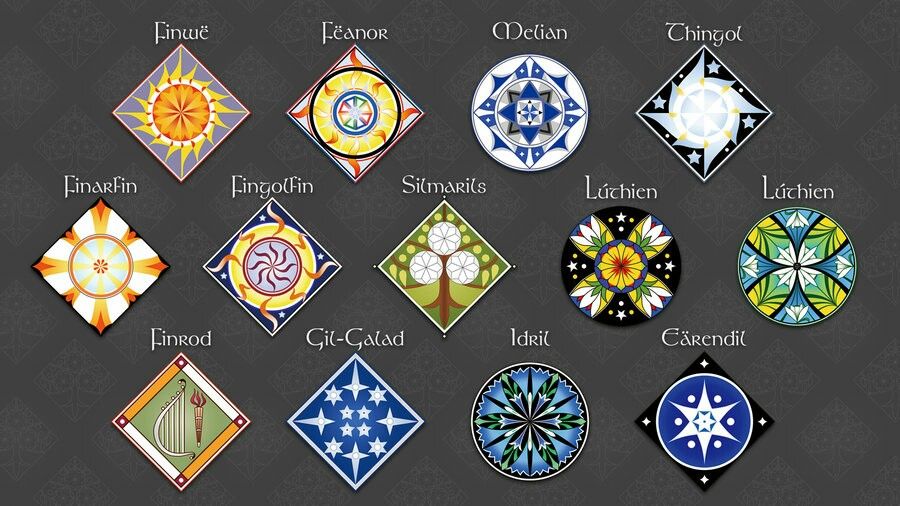
Finarfin’s eight-rayed lozenge-shaped device (see above middle-left) offers a lot of similarity. However, the rays do not taper in the same way as the devices Galadriel bears in The Rings of Power material. That being said, there is an intriguing note that “this device was also used by Finarfin’s heirs, and apparently especially Finrod (though he was also given another device).”
This becomes more curious since in The Rings of Power teaser trailer we see Finrod wearing the exact same device as Galadriel in a scene where he and other elves battle desperately against a host of orcs. Could this device be a House of Finarfin thing?
Well, we also see in the same scene that some of Finrod’s equally embattled retinue sport the self-same device. Now, one might observe that folk of Finrod’s own house might bear the same device. Absolutely, they might.
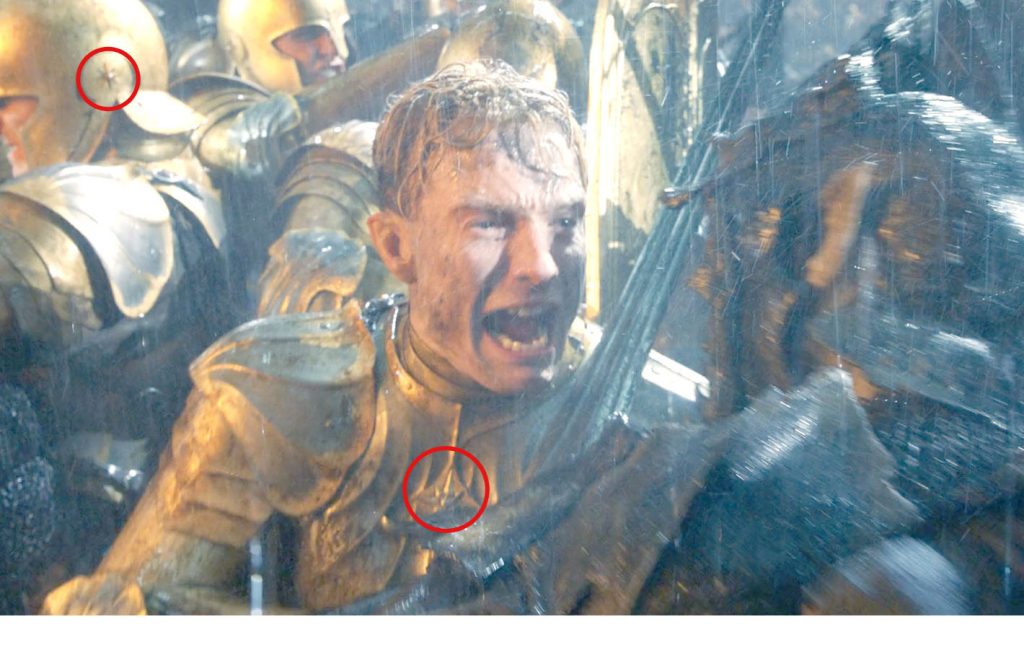
The same device is also present on the shoulder of the as-yet-unidentified fellow caught up in an unfortunate encounter with some kind of troll in the Amazon teaser trailer. Is that another member of Finarfin’s house? Could it be Angrod, or Aegnor? As yet, we don’t know for sure.
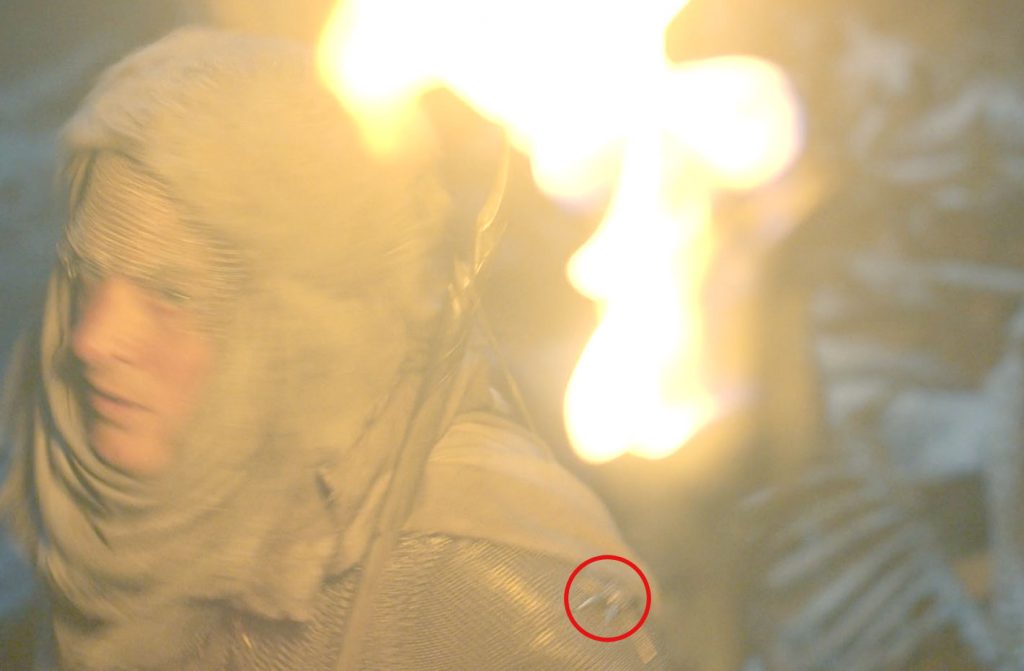
One also observes the exact same device on the waist of the attire of an individual dressed in gold on one of the The Rings of Power teaser posters and in the teaser trailer. We believe this individual to be Gil-galad.
Now, Gil-galad is not of Finarfin’s house; he wouldn’t wear Finarfin’s device. In fact, Tolkien gives Gil-galad his very own device — one of white stars set on a blue field (or sky). This seems to be a strong argument against any conclusion that it’s Finarfin’s device. It seems we must search elsewhere for better answers.
UPDATE: please check the bootnote at the end for an addendum on Gil-galad’s parentage.
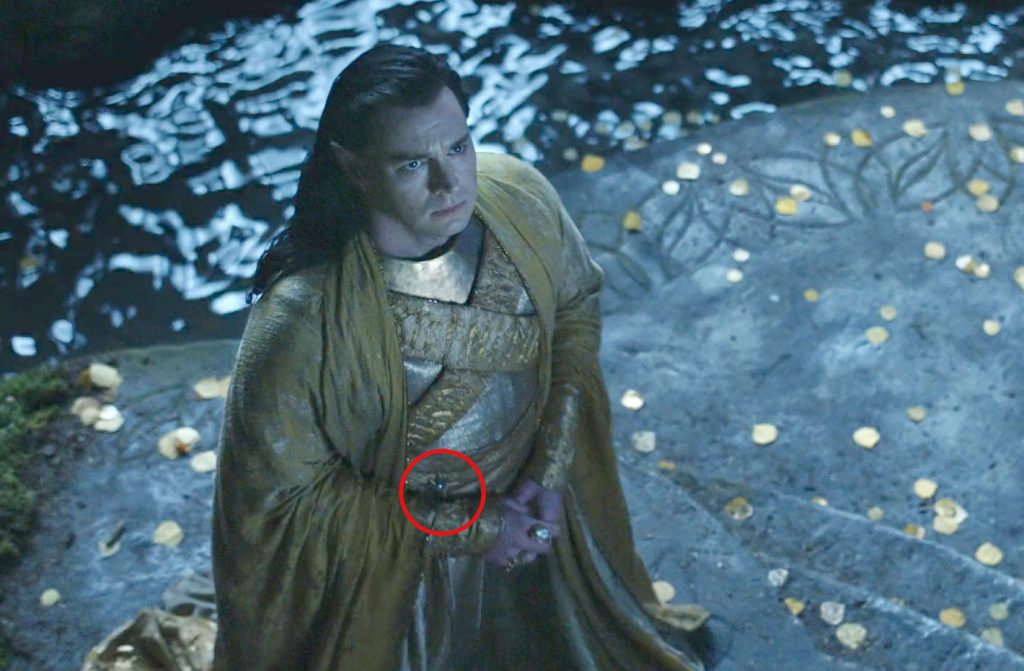
Arguably, Eärendil’s sign might be something they could all unite under — if it matched. The Silmarillion recounts how he become a symbol of hope for all:
Now when first Vingilot was set to sail in the seas of heaven, it rose unlocked for, glittering and bright; and the people of Middle-earth beheld it from afar and wondered, and they took it for a sign, and called it Gil-Estel, the Star of High Hope. And when this new star was seen at evening, Maedhros spoke to Maglor his brother, and he said: ‘Surely that is a Silmaril that shines now in the West?’
Of the Voyage of Eärendil and the War of Wrath, The Silmarillion
Some support for this perspective can be gleaned from one of the Vanity Fair “First Look” images. In the one that seems to show Galadriel and Elrond re-uniting in Lindon, there is a large tapestry in the background. This tapestry shows a stylised rayed star very similar to those worn by Galadriel, Gil-galad, Finrod and others.
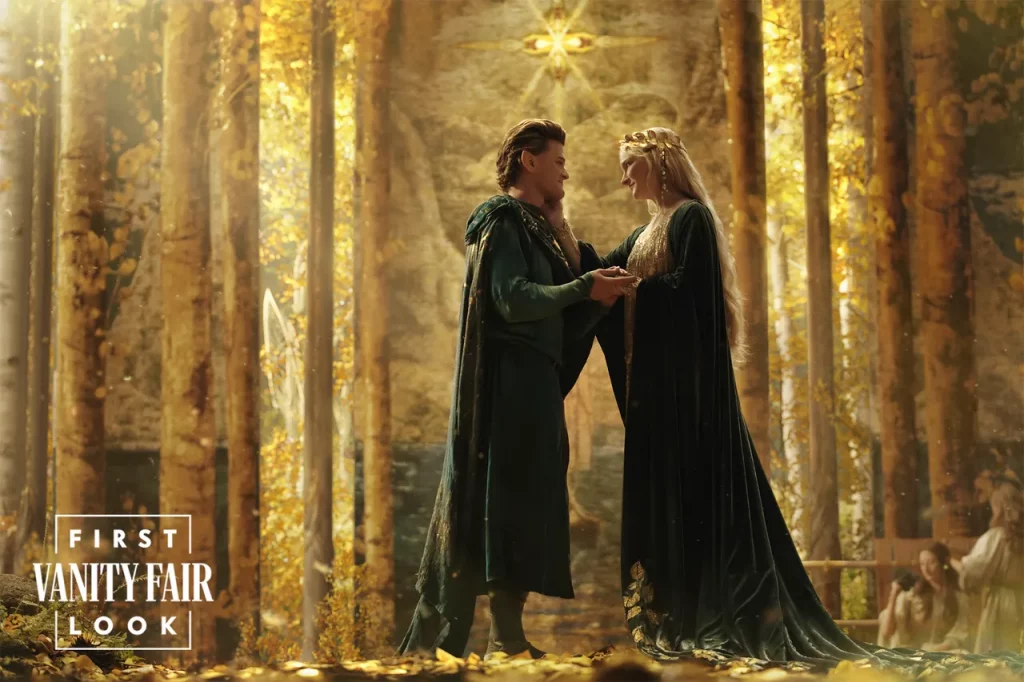
Studios. Note the the ship on the background behind them and the eight-rayed star at the very top of image.
This tapestry also depicts a ship or a boat, seemingly travelling toward, or guided by, the rayed star. Although probably a representation of a ship of the elves taking the journey to Valinor (it’s not yet the Straight Road because this is still the Second Age), the effect of the tapestry still feels evocative of the Star of High Hope mentioned above.
However, the heraldry of Eärendil is a six-pointed star, not one with eight points. I guess elven representations of Gil-Estel could be different — but the fact remains that what we see is just not Eärendil’s emblem.
There is one star that does seem a better visual fit: the Star of Fëanor that we encounter in the Lord of the Rings on The Doors of Durin at the west-entrance to Khazad-dûm.
‘There are the emblems of Durin!’ cried Gimli.
A Journey in the Dark, The Lord of the Rings
‘And there is the Tree of the High Elves!’ said Legolas.
‘And the Star of the House of Fëanor,’ said Gandalf.

Like the emblem of Finarfin, there is a resemblance: eight rays and a distinct tapering. Perhaps more resemblance because of the tapering. Yet, it is also not exact: the four ordinal points are noticeably shorter than those we see on the device Tolkien created for The Doors of Durin.
There are additional (non-visual) contradictions.
Galadriel wouldn’t wear a symbol of the House of Fëanor. First, she’s of Finarfin’s house and would use his badge first. Second, Tolkien observes in Unfinished Tales that Galadriel had an abiding dislike of Fëanor. It’s that simple.
Just as importantly, Gil-galad wouldn’t either — not even as some symbol of solidarity. That’s because, throughout the Second Age, Gil-galad is the (undisputed) high-king of the Noldor in Middle-earth. The House of Fëanor is subsidiary to him in the Noldorin hierarchy.
Maedhros begged forgiveness for the desertion in Araman; and he waived his claim to kingship over all the Noldor, saying to Fingolfin: ‘If there lay no grievance between us, lord, still the kingship would rightly come to you, the eldest here of the house of Finwë, and not the least wise.’ [and] even as Mandos foretold the House of Fëanor were called the Dispossessed, because the over-lordship passed from it, the elder, to the house of Fingolfin, both in Elendë and in Beleriand.
Of the Return of the Noldor, The Silmarillion
Unfortunately, none of the options above fits neatly — every option creates unsatisfactory questions.
If this is the case, this prompts the question: why the lack of a good match?
Likely, the answer simply boils down to the intellectual property rights that Amazon holds for its TV series. (You might note that PJ’s Gil-Galad actually bears his Tolkienian heraldic symbol. The reason is probably down to a difference in the rights available.)
The showrunners have clearly stated (via Vanity Fair) that Amazon bought rights “solely to The Fellowship of the Ring, The Two Towers, The Return of the King, the appendices, and The Hobbit.” Nothing else.
That would place all the heraldic devices that Tolkien crafted out of reach — except the Star of Fëanor. But the showrunners are likely well-aware of the lore-clash of directly applying the Fëanorian star unilaterally.
Instead, it appears they’ve opted for something similar, but not exact — a generic derivation that they hope is symbolically evocative of elven heraldry and the elven reverence for Varda as the Lady of the Stars without directly contradicting one of the more obscure parts of the Legendarium (I love this stuff, but let’s face it — it is super-obscure).
That’s what I suggest is most likely occurring here.
Have they succeeded with that? On this point, I’m not convinced. Yes, it’s evocative — without a doubt. Yet the design still seems a little too similar to Fëanor’s star. I think it also leaves their hands tied when it comes to Celebrimbor. Because Celebrimbor should be the one using the Fëanorian star. Now, if they do try to replicate that, precisely as shown in The Lord of the Rings, will it even look different enough for us to notice?
BOOTNOTE: AlexP reminded me of something that I’d forgotten: Gil-galad’s parentage is complicated. The Silmarillion and Unfinished Tales as edited by Christopher Tolkien state that Gil-galad is the son of Fingon. Later, in preparing The History of Middle-earth, CJRT decided this was an editorial error and that his father’s final decision was that Gil-galad was a son of Orodreth. At the same time, Tolkien switched Orodreth to being a son of Angrod.
What does that mean?
Well, if Amazon were to leave the parentage of Gil-galad implied rather than stated (CJRT himself felt he should have, in retrospect left it obscure in The Silmarillion), then maybe Tolkien Estate would allow it. All three wearers of the badge — Galadriel, Gil-galad and, we presume, our unknown troll fighter — become Finarfin’s heirs. As such it could be argued that it’s fitting for them to use his symbol for the reasons discussed above. It could be a gesture of family solidarity. Even the star we see in the tapestry in the Gala-Elrond image is a fit, because Lindon is the heart of Gil-galad’s kingdom.
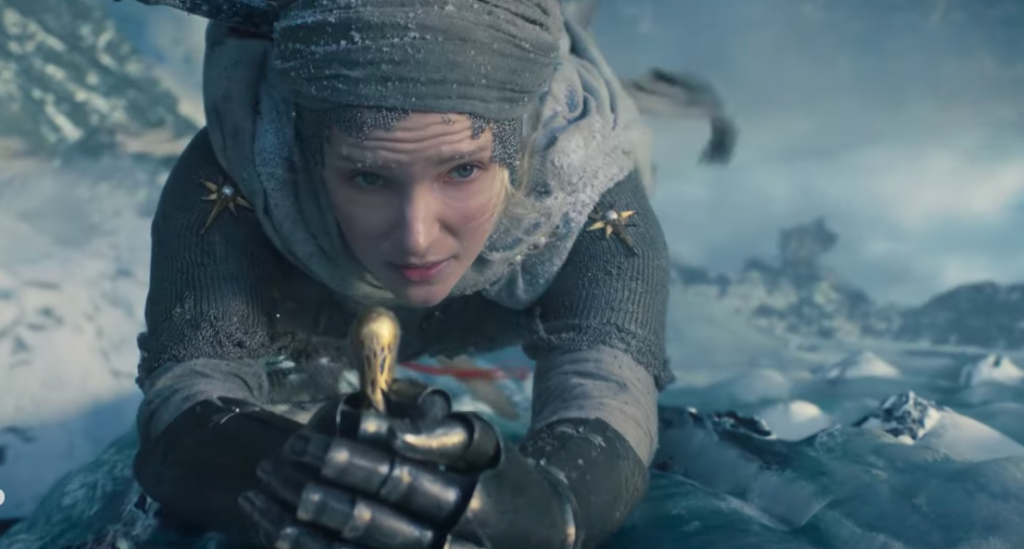
About the author: Staffer Demosthenes has been involved with TheOneRing.net since 2001, serving first as an Associate News Editor, then as Chief News Editor during the making of the Hobbit films. Now he focuses on features and analysis. The opinions in this article are his own and do not necessarily represent those of TheOneRing.net and other staff.
Acknowledgements: I got a lot of assistance from keen-eyed folks on our Discord in pulling this together. So in no particular order (and apologies to anyone else who contributed that I’ve missed), many thanks to DurinDeathless, LadyNico, Lasswen, AlexP, SirSquatch, Sid and Sir Skrilldor.


